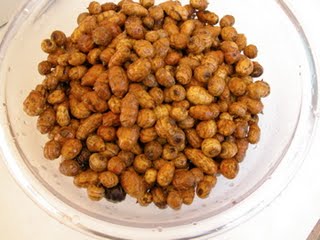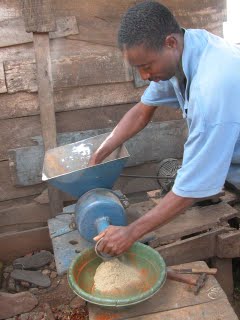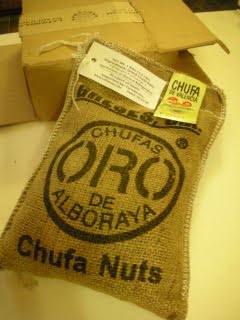Recipe #26: Atadwe Milkye (Tiger Nut Pudding)
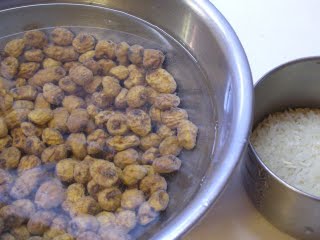 I just rinsed the tiger nuts (chufa), measured them out and put them on to soak for a few hours. The proportions we used in Ghana were basically 1 to 4: one part rice to 4 parts tiger nuts. I was told for a richer version you can increase the rice. Some people soak the nuts overnight, and some also soak the rice, but at Flair we did neither. For this first testing, I'm going with a cup of tiger nuts to 1/4 cup of long grain white rice (I understand you can also use rice flour in the same proportion).
I just rinsed the tiger nuts (chufa), measured them out and put them on to soak for a few hours. The proportions we used in Ghana were basically 1 to 4: one part rice to 4 parts tiger nuts. I was told for a richer version you can increase the rice. Some people soak the nuts overnight, and some also soak the rice, but at Flair we did neither. For this first testing, I'm going with a cup of tiger nuts to 1/4 cup of long grain white rice (I understand you can also use rice flour in the same proportion).I was somewhat disappointed in the tiger nuts shipped from Valencia: in Ghana they were always very fresh, but these look like they've seen better days. I'm avoiding shriveled ones (like the cluster on the right in the photo below), and I am still happy to have ANY chufa to use. I wonder how I could get some fresher ones from the U.S., though? At any rate, make sure to pick over the nuts when you are rinsing them (a couple of times) and discard the shriveled or discolored ones, which may just float to the top. Cover the nuts with cold water and let them sit for several hours. It's noon here, so I'll let them soak until 3 p.m., then grind them together in my food processor and continue.
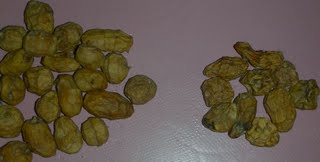 (Whoops, that didn't happen. See the rest of this blog posting).
(Whoops, that didn't happen. See the rest of this blog posting).Update: these chufa are so hard and dry I'm going to let them soak overnight. Sorry I won't be able to tell you how it works until I've tested the recipe (I have 3 separate batches going to see what works best). In the meantime, it's interesting that even though all the online information about chufa acknowledges that the root/nut originated in ancient Egypt, and was carried later to Spain and Mexico, no one seems to realize that it's currently eaten in West Africa.
That's another reason why we need more people speaking out about African cuisines! BTW, apparently the Ga name for atadwe milkye is ataanme nmliche (thank you Anthia-Ofo). I believe the Ewe name is atagbe mekye (correct me if I'm wrong). I guess you'll have to wait another day for news on how this turns out.
After soaking the tiger nuts overnight, I'll drain and rinse them, then attempt to grind them together in a food processor (or my blender) until they form a fine powder kind of like cornmeal, only softer.
I'll then mix in about 1.5 cups of water to help release the "milk" from the nuts. I'll likely use my hand for this so I can squeeze the mixture through my fingers.
The next step will be straining it, first using a metal strainer into a bowl, removing as much water as possible. I'll use 2/3 cup of water at the end to rinse the remaining "chaff" (the "dregs") into the bowl with the "milk."
In Ghana we then strained the "milk" through a very fine metal strainer, and finally through a silk scarf to get every piece of "chaff" out (I'll use a cheesecloth for part of this, but don't know yet what I'll do about the silk scarf). We may get almost another half a cup of the "chaff" out in the end.
It will then be time to cook the pudding, adding a bit of salt (maybe 1/2 teaspoon) and a little sugar (about 1/4 cup), bring it to a boil, then quickly reduce the heat to simmer, stirring constantly for about 10-12 minutes, until it thickens. It can be poured into a serving bowl, or individual dishes, or into a mold (like a jello mold), and cooled before serving.
Barbara says she likes to serve this in clear glass serving dishes, and sometimes colors it slightly yellow, or even layers it in 3 separate colors, like pink, yellow, and the natural color. One cookbook from Ghana suggests coloring it with "black jack," which may be a mineral, but I'm not sure.
So, that's the basic recipe. I'll confirm it tomorrow.
One final note: I've always hosted this blog on my own server, but will soon transfer it to blogger's so that I can take advantage of identifying "followers," you loyal readers who keep me motivated to continue posting.
Labels: ataanme nmliche, atadwe miklye, atagbe mekye, chufa, tiger nut milk
